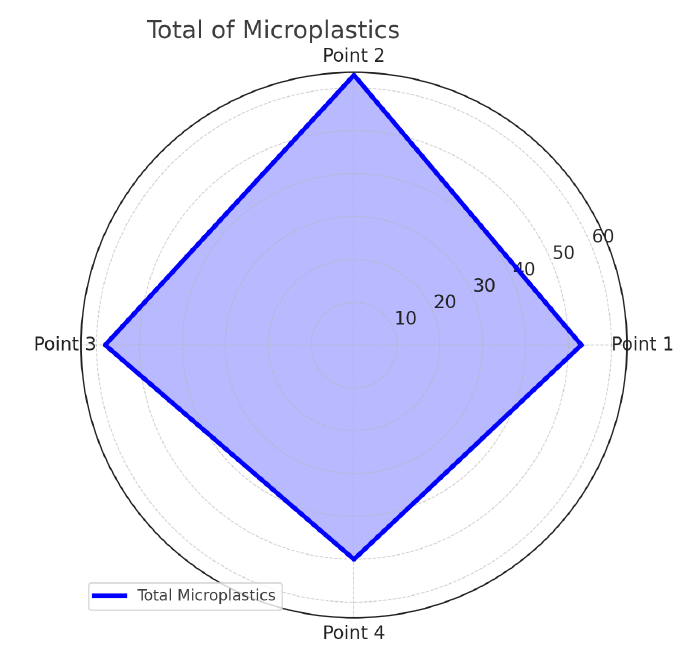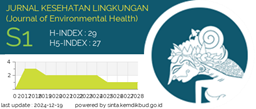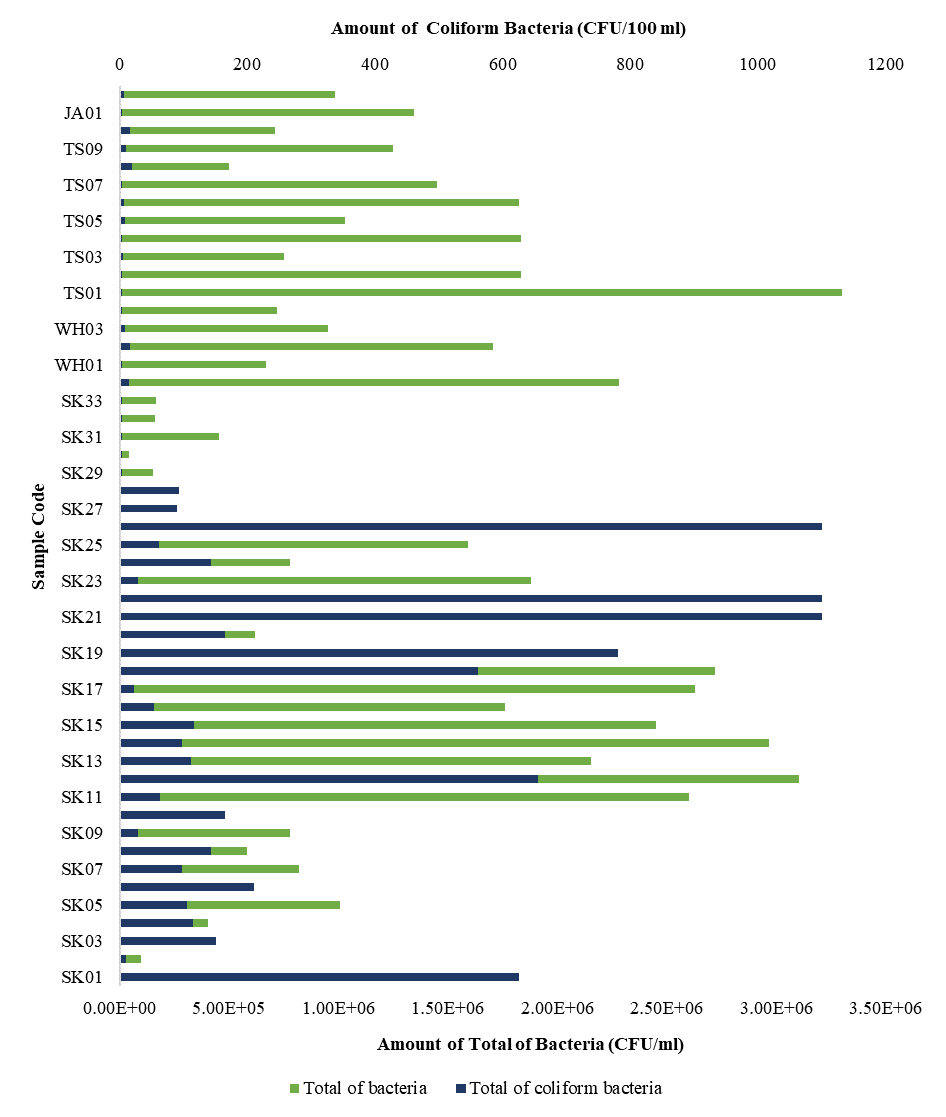Characterization of Airborne Microplastics Particles on Urban Roads: Types, Sizes, and Total Particles

Introduction: Airborne microplastics are part of air pollution that can enter the body orally, through direct contact with the skin and inhalation. Microplastic pollution raises concerns about health and environmental impacts, especially in urban areas with high activity. This study aims to characterize microplastic particles suspended in the air on urban roads by identifying the type, size, and total number of particles. Methods: Sampling method was carried out systematically in four strategic locations with high traffic levels. Laboratory analysis using a combination of spectroscopy and optical microscopy techniques were carried out to identify the type of polymer contained in the particles and to measure the particle size distribution in detail. Results and Discussion: This study identified a total of 223 airborne microplastic particles across four urban sites, dominated by fiber types (>80%), likely from synthetic textiles. Particle sizes ranged from 0.2 mm to 4.8 mm, with Small Microplastics (<1 mm) comprising over 60% and posing potential respiratory health risks. The highest concentration was found at Point 2 (63 particles), influenced by high traffic and nearby industry. Conclusion: Microplastics, which are predominantly in the form of fibers, especially small (<1 mm) in size, which are easily dispersed by the wind and have the potential to endanger health through inhalation, are thought to come from tire friction and industrial and household activities.
Moradi M, Behnoush AH, Abbasi‐Kangevari M, Saeedi Moghaddam S, Soleimani Z, Esfahani Z, et al. Particulate Matter Pollution Remains a Threat for Cardiovascular Health: Findings From the Global Burden of Disease 2019. Journal of the American Heart Association. 2023;12(16):1-43. https://doi.org/10.1161/JAHA.123.029375
Syuhada G, Akbar A, Hardiawan D, Pun V, Darmawan A, Heryati SH, et al. Impacts of Air Pollution on Health and Cost of Illness in Jakarta, Indonesia. International Journal of Environmental Research and Public Health. 2023;20(4):1-14. https://doi.org/10.3390/ijerph20042916
Zhao X, You F. Microplastic Human Dietary Uptake from 1990 to 2018 Grew across 109 Major Developing and Industrialized Countries but Can Be Halved by Plastic Debris Removal. Environmental Science & Technology. 2024;58(20):8709–8723. https://doi.org/10.1021/acs.est.4c00010
Ng CH, Mistoh MA, Teo SH, Galassi A, Ibrahim A, Sipaut CS, et al. Plastic Waste and Microplastic Issues in Southeast Asia. Frontiers in Environmental Science. 2023;11(1):1-15. https://doi.org/10.3389/fenvs.2023.1142071
Aliansi Zero Waste Indonesia. Udara Jawa Timur Terkepung Mikroplastik. Jakarta; Aliansi Zero Waste Indonesia: 2022. https://aliansizerowaste.id/2022/04/18/udara-jawa-timur-terkepung-mikroplastik/
Vouitsis I, Portugal J, Kontses A, Karlsson HL, Faria M, Elihn K, et al. Transport-Related Airborne Nanoparticles: Sources, Different Aerosol Modes, and Their Toxicity. Atmospheric Environment. 2023;301(1):1-20. https://doi.org/10.1016/j.atmosenv.2023.119698
Järlskog I, Strömvall A-M, Magnusson K, Gustafsson M, Polukarova M, Galfi H, et al. Occurrence of Tire and Bitumen Wear Microplastics on Urban Streets and In Sweepsand and Washwater. Science of The Total Environment. 2020;729(1):1-13. https://doi.org/10.1016/j.scitotenv.2020.138950
Tamis JE, Koelmans AA, Dröge R, Kaag NHBM, Keur MC, Tromp PC, et al. Environmental Risks of Car Tire Microplastic Particles and Other Road Runoff Pollutants. Microplastics and Nanoplastics. 2021;1(1):1-17. https://doi.org/10.1186/s43591-021-00008-w
Giechaskiel B, Grigoratos T, Mathissen M, Quik J, Tromp P, Gustafsson M, et al. Contribution of Road Vehicle Tyre Wear to Microplastics and Ambient Air Pollution. Sustainability. 2024;16(2):1-31. https://doi.org/10.3390/su16020522
Kaydi N, Jorfi S, Takdastan A, Jaafarzadeh Haghighifard N, Khafaie MA. Source Identification and Apportionment of Ambient Air Microplastics: A Systematic Review. Discover Applied Sciences. 2024;7(1):1-21. https://doi.org/10.1007/s42452-024-06422-y
Rafa N, Ahmed B, Zohora F, Bakya J, Ahmed S, Ahmed SF, et al. Microplastics As Carriers of Toxic Pollutants: Source, Transport, and Toxicological Effects. Environmental Pollution. 2024;343(1):1-25. https://doi.org/10.1016/j.envpol.2023.123190
Jannah BR, Maharani HA, Rahmawati S, Nugroho AR, Abdull NB. Occurrence and Characteristic of Microplastics In Suspended Particulate, A Case Study In Street of Yogyakarta. E3S Web of Conf. 2024;485(1):1-10. https://doi.org/10.1051/e3sconf/202448506008
Liu K, Wang X, Fang T, Xu P, Zhu L, Li D. Source and Potential Risk Assessment of Suspended Atmospheric Microplastics in Shanghai. Science of The Total Environment. 2019;675(1):462–471. https://doi.org/10.1016/j.scitotenv.2019.04.110
Yan M, Nie H, Xu K, He Y, Hu Y, Huang Y, et al. Microplastic Abundance, Distribution and Composition in The Pearl River Along Guangzhou City and Pearl River Estuary, China. Chemosphere. 2019;217(1):879-886. https://doi.org/10.1016/j.chemosphere.2018.11.093
Ashrafy A, Liza AA, Islam MN, Billah MM, Arafat ST, Rahman MM, et al. Microplastics Pollution: A Brief Review of Its Source and Abundance in Different Aquatic Ecosystems. Journal of Hazardous Materials Advances. 2023;9(1):1-12. https://doi.org/10.1016/j.hazadv.2022.100215
Fiore L, Serranti S, Mazziotti C, Riccardi E, Benzi M, Bonifazi G. Classification and Distribution of Freshwater Microplastics Along The Italian Po River by Hyperspectral Imaging. Environmental Science and Pollution Research. 2022;29(32):48588–48606. https://doi.org/10.1007/s11356-022-18501-x
Firdaus M, Trihadiningrum Y, Lestari P. Microplastic pollution in the sediment of Jagir Estuary, Surabaya City, Indonesia. Marine Pollution Bulletin. 2020;150(1):1-9. https://doi.org/10.1016/j.marpolbul.2019.110790
Abbasi S, Keshavarzi B, Moore F, Turner A, Kelly FJ, Dominguez AO, et al. Distribution and Potential Health Impacts of Microplastics And Microrubbers in Air and Street Dusts from Asaluyeh County, Iran. Environmental Pollution. 2019;244(1):153–164. https://doi.org/10.1016/j.envpol.2018.10.039
Unice KM, Weeber MP, Abramson MM, Reid RCD, van Gils JAG, Markus AA, et al. Characterizing Export Of Land-Based Microplastics to The Estuary - Part I: Application of Integrated Geospatial Microplastic Transport Models to Assess Tire and Road Wear Particles in the Seine Watershed. Science of The Total Environment. 2019;646:1639–1649. https://doi.org/10.1016/j.scitotenv.2018.07.368
Fang Q, Niu S-P, Chen Y-D, Yu J-H. Characteristics of Microplastic Present in Urban Road Dust. Huan Jing Ke Xue. 2022;43(1):189–198. https://doi.org/10.13227/j.hjkx.202103147
Henry B, Laitala K, Klepp IG. Microfibres from Apparel and Home Textiles: Prospects For Including Microplastics In Environmental Sustainability Assessment. Science of The Total Environment. 2019;652:483–494. https://doi.org/10.1016/j.scitotenv.2018.10.166
Egan J, Salmon S. Strategies and Progress in Synthetic Textile Fiber Biodegradability. SN Applied Sciences. 2021;4(1):1-36. https://doi.org/10.1007/s42452-021-04851-7
Özen HA, Mutuk T. The Influence Of Road Vehicle Tyre Wear on Microplastics in A High-Traffic University For Sustainable Transportation. Environmental Pollution. 2025;367(1):1-9. https://doi.org/10.1016/j.envpol.2024.125536
Surendran D, Sakai H, Takagi S, Dimapilis DA. Tire-based microplastics: Composition, Detection, and Impacts Of Advanced Oxidation Processes in Drinking Water Treatment. Science of The Total Environment. 2025;972(1):1-10. https://doi.org/10.1016/j.scitotenv.2025.179114
Tian L, Zhao S, Zhang R, Lv S, Chen D, Li J, et al. Tire Wear Chemicals in the Urban Atmosphere: Significant Contributions of Tire Wear Particles to PM2.5. Environmental Science & Technology. 2024;58(38):16952–16961. https://doi.org/10.1021/acs.est.4c04378
Baensch-Baltruschat B, Kocher B, Stock F, Reifferscheid G. Tyre and Road Wear Particles (TRWP) - A Review Of Generation, Properties, Emissions, Human Health Risk, Ecotoxicity, and Fate In The Environment. Science of The Total Environment. 2020;733(1):1-19. https://doi.org/10.1016/j.scitotenv.2020.137823
Österlund H, Blecken G, Lange K, Marsalek J, Gopinath K, Viklander M. Microplastics in Urban Catchments: Review of Sources, Pathways, a nd Entry Into Stormwater. Science of The Total Environment. 2023;858(1):1-17. https://doi.org/10.1016/j.scitotenv.2022.159781
Lin Y, Wang Y, Ho Y-W, Fang JK-H, Li Y. Characterization and Ecological Risks of Microplastics in Urban Road Runoff. Science of The Total Environment. 2024;954(1):1-12. https://doi.org/10.1016/j.scitotenv.2024.176590
He B, Shi C, Chen B, Wu H, Goonetilleke A, Liu A. Occurrence and Risk Associated with Urban Road-Deposited Microplastics. Journal of Hazardous Materials. 2023;459(1):1-11. https://doi.org/10.1016/j.jhazmat.2023.132012
Li W, Wang S, Wufuer R, Duo J, Pan X. Microplastic Contamination in Urban, Farmland and Desert Environments along a Highway in Southern Xinjiang, China. International Journal of Environmental Research and Public Health. 2022;19(15):1-12. https://doi.org/10.3390/ijerph19158890
Cordova MR, Purwiyanto AIS, Suteja Y. Abundance and Characteristics of Microplastics In The Northern Coastal Waters of Surabaya, Indonesia. Marine Pollution Bulletin. 2019;142(1):183–188. https://doi.org/10.1016/j.marpolbul.2019.03.040
Matin Roohbakhsh Panbeh M. Assessing the Impact of Reduced Vehicle Volume and Increased Speed on Air Quality in Qom City Using AERMOD. International journal of Modern Achievement in Science, Engineering and Technology. 2025;2(1):115–132. https://doi.org/10.63053/ijset.69
Noorimotlagh Z, Hopke PK, Mirzaee SA. A Systematic Review Of Airborne Microplastics Emissions As Emerging Contaminants in Outdoor and Indoor Air Environments. Emerging Contaminants. 2024;10(4):1-12. https://doi.org/10.1016/j.emcon.2024.100372
Vijayan A, Österlund H, Magnusson K, Marsalek J, Viklander M. Microplastics (MPs) in Urban Roadside Snowbanks: Quantities, Size Fractions and Dynamics of Release. Science of The Total Environment. 2022;851(1):1-14. https://doi.org/10.1016/j.scitotenv.2022.158306
Evangeliou N, Grythe H, Klimont Z, Heyes C, Eckhardt S, Lopez-Aparicio S, et al. Atmospheric Transport is A Major Pathway of Microplastics to Remote Regions. Nature Communications. 2020;11(1):1-11. https://doi.org/10.1038/s41467-020-17201-9
Burghardt TE, Pashkevich A. Road Markings and Microplastics – A Critical Literature Review. Transportation Research Part D: Transport and Environment. 2023;119(1):1-20. https://doi.org/10.1016/j.trd.2023.103740
JJärlskog I, Nyberg E, Fager H, Gustafsson M, Blomqvist G. Microplastic emissions from wear of road markings : overview and assessment for Swedish conditions. Linköping: Statens väg- och transportforskningsinstitut; 2024. https://urn.kb.se/resolve?urn=urn:nbn:se:vti:diva-20676
Fan Y, Zheng J, Xu W, Zhang Q, Chen N, Wang H, et al. Spatiotemporal Occurrence and Characteristics of Microplastics in The Urban Road Dust In A Megacity, Eastern China. Journal of Hazardous Materials. 2024;468(1):1-12. https://doi.org/10.1016/j.jhazmat.2024.133733
Kabir SMA, Bhuiyan MA, Zhang G, Pramanik BK. Microplastic Distribution and Ecological Risks: Investigating Road Dust and Stormwater Runoff Across Land Uses. Environmental Science: Advances. 2024;3(1):62–75. http://dx.doi.org/10.1039/D3VA00128H
Borris M, Österlund H, Marsalek J, Viklander M. Snow Pollution Management In Urban Areas: An Idea Whose Time Has Come? Urban Water Journal. 2021;18(10):840–849. https://doi.org/10.1080/1573062X.2021.1941138
Mierzyńska K, Pol W, Martyniuk M, Zieliński P. Traffic Intensity as a Factor Influencing Microplastic and Tire Wear Particle Pollution in Snow Accumulated on Urban Roads. Water. 2024;16(1):1-16. https://doi.org/10.3390/w16202907

This work is licensed under a Creative Commons Attribution-NonCommercial-ShareAlike 4.0 International License.
1. Copyright of all journal manuscripts is held by the Jurnal Kesehatan Lingkungan.2. Formal legal provisions to access digital articles of electronic journal are subject to the provision of the Creative Commons Attribution-ShareAlike license (CC BY-NC-SA), which means that Jurnal Kesehatan Lingkungan is rightful to keep, transfer media/format, manage in the form of databases, maintain, and publish articles.
3. Published manuscripts both printed and electronic are open access for educational, research, and library purposes. Additionally, the editorial board is not responsible for any violations of copyright law.
JKESLING by UNAIR is licensed under a Creative Commons Attribution-ShareAlike 4.0 International License.







































